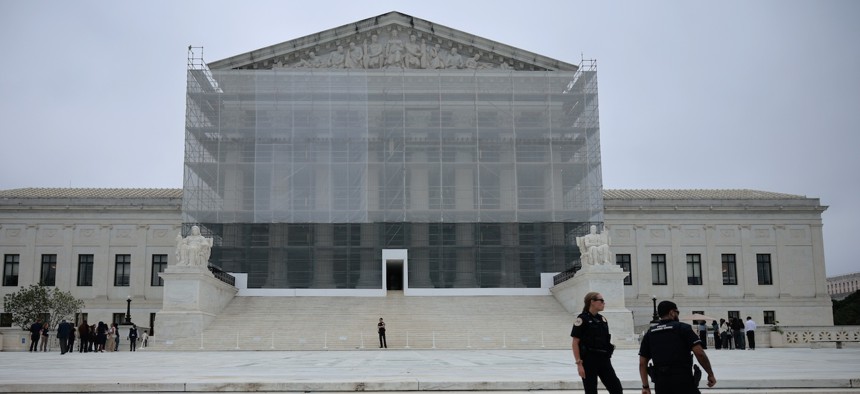
The plaza in front of the U.S. Supreme Court building is closed on the final day of this term on June 27, 2025. The court ruled 6-3 to limit the use of nationwide injunctions. Chip Somodevilla/Getty Images
Mass layoffs likely to remain blocked, for now, thanks to a Supreme Court footnote
The Trump administration is cheering a SCOTUS ruling and its impact on the federal workforce, but attorneys on a key reduction-in-force case say its impact on feds is currently limited.
The Supreme Court on Friday limited individual judges’ capacity to strike down government policy on a nationwide basis, a decision with potentially far-reaching impacts on how federal agencies carry out their work.
The high court left in place some carve outs, however, including one that could—at least temporarily—protect a judge’s ruling that is currently blocking the Trump administration from carrying out widespread layoffs. While the Trump administration applauded the Supreme Court’s decision and lamented the influence that lower-level judges have exerted over the president’s control of the federal workforce, attorneys who helped bring the lawsuit forward suggested it did not apply to the order preventing large-scale reductions in force.
The 6-3 majority opinion in Trump V. CASA, which pertained to the president’s order to end birthright citizenship but did not yet rule on the merits of that case, found national, or “universal,” injunctions likely exceed the authority Congress bestowed upon the judiciary in 1789. Limiting injunctions narrowly to only the named plaintiffs in the case at hand, Justice Amy Coney Barrett said in the opinion, does make the relief it provides to those individuals any less complete.
In a footnote of the opinion, however, Barrett added that nothing in the decision “resolves the distinct question whether the Administrative Procedure Act authorizes federal courts to vacate federal agency action.” District court judges in both the larger RIF injunction and one more specifically tailored to the Education Department relied in part on the APA to support their findings.
“There is nothing in the decision that appears to undercut universal relief or vacature that you see under the Administrative Procedure Act, which is a statute that a number of the cases that have been brought against the administration to remedy their lawlessness [have] utilized,” said Skye Perryman, president of Democracy Forward, a group that has led legal challenges to many of the Trump administration’s polices and helped organize the lawsuits in the overall, and Education-specific, RIF cases.
The APA protects Americans from "unlawful, arbitrary and capricious governmental action," Perryman added, noting the court was "quite clear" its curbing of nationwide injunctions would not apply to cases involving that law. She also pointed out the decision allows for broach-reaching injunctions when necessary to provide relief to plaintiffs on the case, and appeared to allow states to sue the federal government and receive injunctions on behalf of their citizens. The case challenging layoffs at 22 agencies applies to unions and other groups with members across the country, while the Education lawsuit was brought by 20 states.
At the White House on Friday, President Trump and Justice Department officials spoke to reporters to celebrate the court’s decision and rebuke courts that have blocked Trump from carrying out his directives on a nationwide basis in 40 instances. The decisions, they said, created significant burdens across the administration, including as it has sought to shrink the federal workforce.
“We had another stay of an order forcing reinstatement of fired executive branch employees, entirely within the president—and Article II—his right to do,” said Deputy Attorney General Todd Blanche.
The larger RIF injunction has not yet required agencies to reinstate anyone, though it has at some agencies kept on the rolls employees who previously received layoff notices. The judge in the Education case has called on the Trump administration to reinstate employees to their jobs. Previous injunctions forced the Trump administration to reinstate recently hired federal employees agencies had fired en masse, but the Supreme Court already reversed those orders.
Speaking to the larger implications of Friday’s decision, Attorney General Pam Bondi said the judiciary had attempted to “seize the executive branch’s power.”
“It can no longer do that,” Bondi said.
Perryman said it will be watching closely to see how the administration reacts in court to the Supreme Court’s decision.
“It appeared as if the people from the Department of Justice, as well as the White House itself, is taking a very broad view of this ruling,” Perryman said. “And so we're going to monitor the cases as to what they may do.”
The victory for federal employees, to the extent they can claim one after the Supreme Court's decision, may be short lived. The administration has already appealed both RIF cases to the court, where it is now awaiting resolution. It has done so seeking emergency relief and a decision is expected any day.
Agencies across government have taken steps to swiftly implement layoffs if the Supreme Court rules in the administration’s favor.
Share your news tips with us:
Eric Katz: ekatz@govexec.com, Signal: erickatz.28
NEXT STORY: At some federal beaches, surf’s up but the lifeguard chair’s empty







